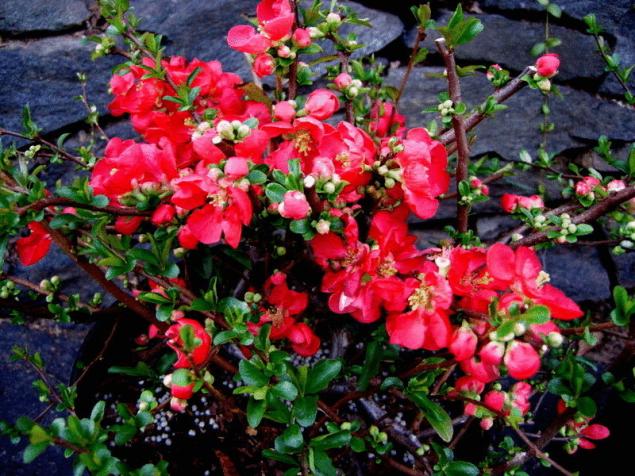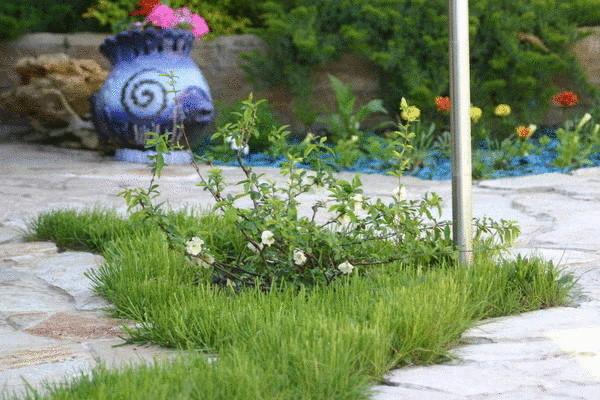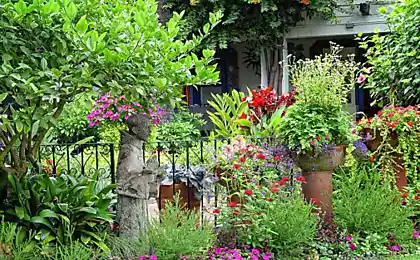398
April beauty Japan quince

Increasingly, the beauty of spring giving support chaenomeles – thorny bushes, covered with bright flowers, attracts attention from afar. This flowering does not interfere with even the leaves come in some varieties flower much later. Chaenomeles grow quickly; they are quite unpretentious, drought-resistant that allows for their wider use in arid regions. Adding to these virtues and value of fruit, discover useful plants.
Botanical sprachenatelier (Chaenomeles) is a small genus of the rose family/Rosaceae, consisting of 3 species found in China and Japan; all 3 species with numerous decorative varieties successfully cultivated in Russia. Most often it is a shrub 0.5-2 m with spiny branches, dark green, shiny, simple leaves and very showy, large, mostly orange or red flowers that bloom in early spring before the leaves. Fruits – a variety of shapes and colors (from greenish-yellow to bright yellow), hard-seeded, sour, very aromatic apples.
Despite the resemblance, chaenomeles are different.
The excellent Japan quince (Chaenomeles x superba)Is a hybrid Japan quince Japanese and Japan quince is beautiful. Densely branched shrub 1.2-1.5 m, with thorns. Leaves ovate-elongated, dark green, dense, shiny. Flowers large, solitary or in bunches, orange, red, white or pink, with a diameter of 4 cm; blooming in April-may, profuse flowering, long lasting, up to 4 weeks. Fruits – oblong-roundish, greenish-yellow or yellow apples, with a diameter of 3-6 cm; ripen in September-October.
Ornamental varieties
- ‘Crimson and Gold’ (compact shrub, flowers dark red with Golden anthers);
- ‘Elly Mossel’ (large red flowers);
- ‘Fire Dance’ (flowers large, moderately red);
- ‘Nicoline’ (flowers large, semi-double, red);
- ‘Pink Lady’ (pink flowers, bloom earlier)
The Japanese Maulay or Japan quince (Chaenomeles japonica syn. C. maulei)Shrub to 1 m, with spines 1-1. 5 cm Leaves broadly ovate, 3-5 cm in length, dark green, dense, shiny. The flowers are large, brick-red, with a diameter of 5 cm, 2-4 in clusters; bloom in April-may, profuse flowering, long lasting, up to 4 weeks. The fruit is round, greenish-yellow or yellow, fragrant apples, 4-5 cm in diameter; ripen in September-October.
Features kultivirovanija quite hardy and overwinter without shelter even in the Northern regions of Russia (except Japan quince fine), however, young plants better shelter spruce branches. They prefer open Sunny places. Chaenomeles relatively drought tolerant, but in hot, dry summers require irrigation; they are not demanding to soil but grow best on sandy loam and light loamy soils rich in humus, without excessive moisture. After flowering cut the faded shoots to the developed buds or young lower shoots. The old hedge of Japanese quince rejuvenate, spending additional pruning old branches, leaving 1/4 — 1/5 of the length. Chaenomeles resistant to pests and diseases, but sometimes can be damaged by scale insects, aphids and be affected by brown rot, a bacterial burn.
Features postcycle planting time – spring. Prepare the planting hole, based on the volume of the clod of earth (for plants with closed root system), or length of roots (for plants with open root system). The seedling is placed around the center of the pit, the roots fall asleep fertile soil, compacting it around the plants; watered. When planting, consider the position of the root collar (junction of the trunk to the root): as a rule, it needs to be at soil level.
The use of chaenomeles on даче

All chaenomeles very decorative in groups and solitary plantings. They are suitable to create a low, free-growing, flowering, honey, fruit, herb, prickly hedges and borders, with a possible shallow trimming the sides; used as vygonochnyh culture (January-March) and for cutting. When planting is necessary to consider that seed progeny (blooms on 3-4-th year) and it can vary greatly in height, shape of shrubs, flowers, fruit weight, therefore, for laying hedges is better to use vegetatively propagated forms and varieties (bloom on 2-3rd year) with a known limit height of the Bush.
This interesno Greek the Japan quince means to split the Apple.
In addition, there is a legend that tells that the bright colors of the flowers of the Japan quince is associated with the ancient war between the Japanese and a small Ainu people, who once lived on all the Japanese Islands. Ainu were forced to retreat to the North. And only the bright flowers of the Japan quince remember the courage of the fallen soldiers.published
Source: www.7dach.ru
10 facts about us, which we learned thanks to wearable technology
10 microscopic events with huge impacts on the Ground























